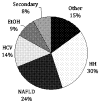Phenotypic characteristics and diagnoses of patients referred to an iron overload clinic
- PMID: 20033846
- PMCID: PMC3481540
- DOI: 10.1007/s10620-009-1080-1
Phenotypic characteristics and diagnoses of patients referred to an iron overload clinic
Abstract
Background: There are limited data on the phenotypic differences between patients with hereditary hemochromatosis (HH) and other forms of iron overload.
Aims: To describe and compare patients suspected of having iron overload disease.
Methods: Patients were evaluated at a university iron overload clinic over a 5-year period. Biochemical and clinical profiles of patients with HH and non-HH causes of suspected iron overload were retrospectively compared.
Results: A total of 270 patients were evaluated during the enrollment period, and 137 (51%) were diagnosed with HH. The most common reasons for referral were elevated serum iron markers (155 patients), followed by positive family history (40 patients), and known HH (75 patients). In patients without HH referred for suspected iron overload, the most common diagnoses were nonalcoholic fatty liver disease (NAFLD) (24%), chronic hepatitis C infection (14%), and alcohol related liver disease (9%). Of the patients with HH, 108 were C282Y homozygotes, 20 were compound heterozygotes (C282Y/H63D), and nine had neither mutation. The following clinical characteristics were significantly different (p < 0.05) between patients with HH and all other referred patients: arthralgia (42 vs. 16%) and decreased libido (11 vs. 4%). There was a non-significant trend towards increased fatigue (44 vs. 33%), diabetes (10 vs. 6%), impotence (8 vs. 4%), and hypothyroidism (10 vs. 6%) in the HH group.
Conclusions: (1) A large proportion of patients referred for suspected iron overload have diagnoses other than HH. (2) NAFLD, chronic hepatitis C, and chronic alcohol use were the most common alternative diagnoses. (3) Arthralgia and fatigue are the most common symptoms among patients with HH.
Conflict of interest statement
Figures




Similar articles
-
Hereditary hemochromatosis in a Brazilian university hospital in São Paulo State (1990-2000).Genet Mol Res. 2005 Mar 31;4(1):31-8. Genet Mol Res. 2005. PMID: 15841433
-
Hepatic iron overload: direct HFE (HLA-H) mutation analysis vs quantitative iron assays for the diagnosis of hereditary hemochromatosis.Am J Clin Pathol. 1998 May;109(5):577-84. doi: 10.1093/ajcp/109.5.577. Am J Clin Pathol. 1998. PMID: 9576576
-
Liver steatosis correlates with iron overload but not with HFE gene mutations in chronic hepatitis C.Hepatobiliary Pancreat Dis Int. 2013 Aug;12(4):377-84. doi: 10.1016/s1499-3872(13)60059-4. Hepatobiliary Pancreat Dis Int. 2013. PMID: 23924495
-
Clinical characteristics of hereditary hemochromatosis patients who lack the C282Y mutation.Hepatology. 1998 Aug;28(2):526-9. doi: 10.1002/hep.510280233. Hepatology. 1998. PMID: 9696020 Review.
-
[Iron overload disease: recent findings].Ann Ital Med Int. 2004 Jul-Sep;19(3):145-54. Ann Ital Med Int. 2004. PMID: 15529941 Review. Italian.
Cited by
-
Towards a unifying, systems biology understanding of large-scale cellular death and destruction caused by poorly liganded iron: Parkinson's, Huntington's, Alzheimer's, prions, bactericides, chemical toxicology and others as examples.Arch Toxicol. 2010 Nov;84(11):825-89. doi: 10.1007/s00204-010-0577-x. Epub 2010 Aug 17. Arch Toxicol. 2010. PMID: 20967426 Free PMC article. Review.
-
HFE genotyping in patients with elevated serum iron indices and liver diseases.Biomed Res Int. 2015;2015:164671. doi: 10.1155/2015/164671. Epub 2015 Jan 14. Biomed Res Int. 2015. PMID: 25654085 Free PMC article.
-
A decade of iron overload disorders and hemochromatosis: clinical and genetic findings from a specialized center in Colombia.Front Med (Lausanne). 2024 Dec 10;11:1494527. doi: 10.3389/fmed.2024.1494527. eCollection 2024. Front Med (Lausanne). 2024. PMID: 39720661 Free PMC article.
-
Synergistic impact of serum uric acid and ferritin on MAFLD risk: A comprehensive cohort analysis.Sci Rep. 2025 May 29;15(1):18936. doi: 10.1038/s41598-025-02914-y. Sci Rep. 2025. PMID: 40442196 Free PMC article.
-
Study of total stimulated saliva flow and hyperpigmentation in the oral mucosa of patients diagnosed with hereditary hemochromatosis. Series of 25 cases.Med Oral Patol Oral Cir Bucal. 2012 Jan 1;17(1):e45-9. doi: 10.4317/medoral.17206. Med Oral Patol Oral Cir Bucal. 2012. PMID: 22157666 Free PMC article.
References
-
- Gurrin LC, Osborne NJ, Constantine CC, et al. The natural history of serum iron indices for HFE C282Y homozygosity associated with hereditary hemochromatosis. Gastroenterology. 2008;135:1945–1952. - PubMed
-
- Beutler E, Felitti JVJ, Koziol JA, et al. Penetrance of the 845G → A (C282Y) HFE hereditary haemochromatosis mutation in the USA. Lancet. 2002;359:211–218. - PubMed
-
- Allen KJ, Gurrin LC, Constantine CC, et al. Iron-overload-related disease in HFE hereditary hemochromatosis. N Engl J Med. 2008;358:221–230. - PubMed
-
- Yen AW, Fancher TL, Bowlus CL. Revisiting hereditary hemochromatosis: current concepts and progress. Am J Med. 2006;119:391–399. - PubMed
-
- Alexander J, Kowdley KV. HFE-associated hereditary hemochromatosis. Genet Med. 2009;11:307–313. - PubMed
Publication types
MeSH terms
Substances
Grants and funding
LinkOut - more resources
Full Text Sources
Medical

